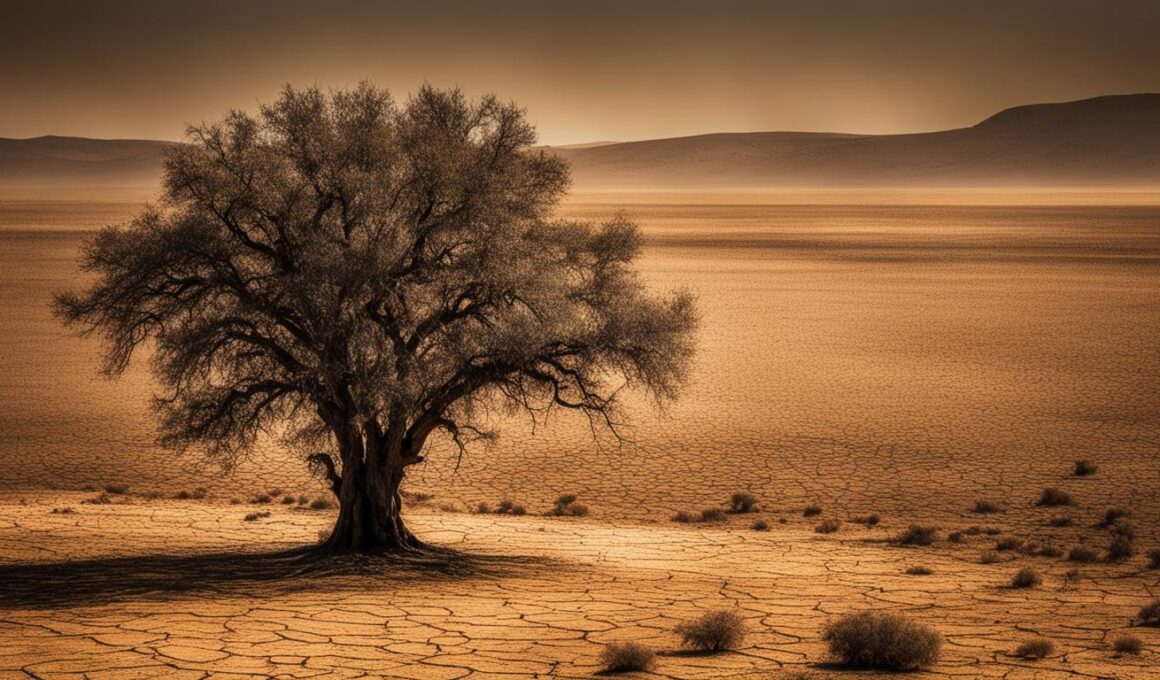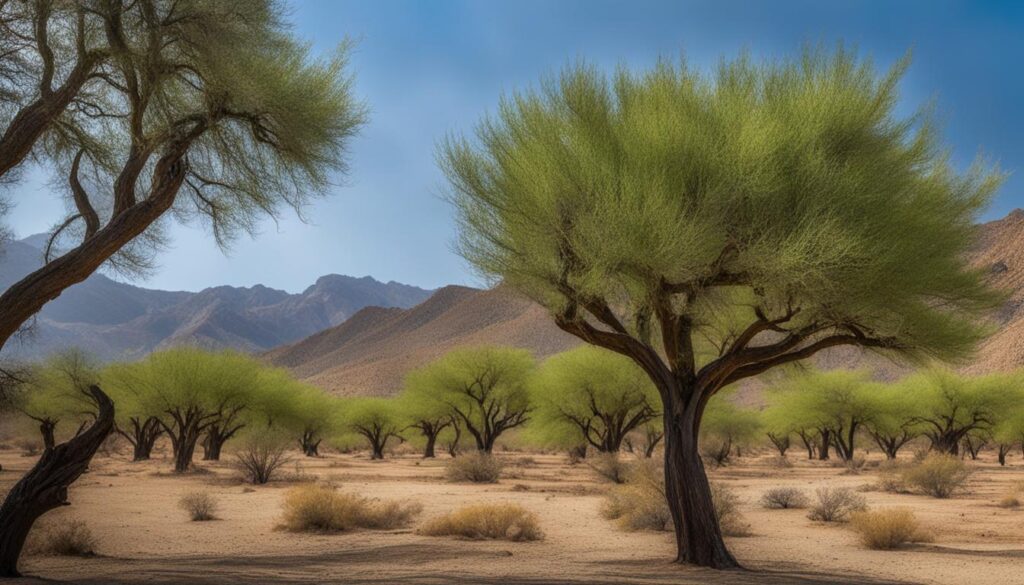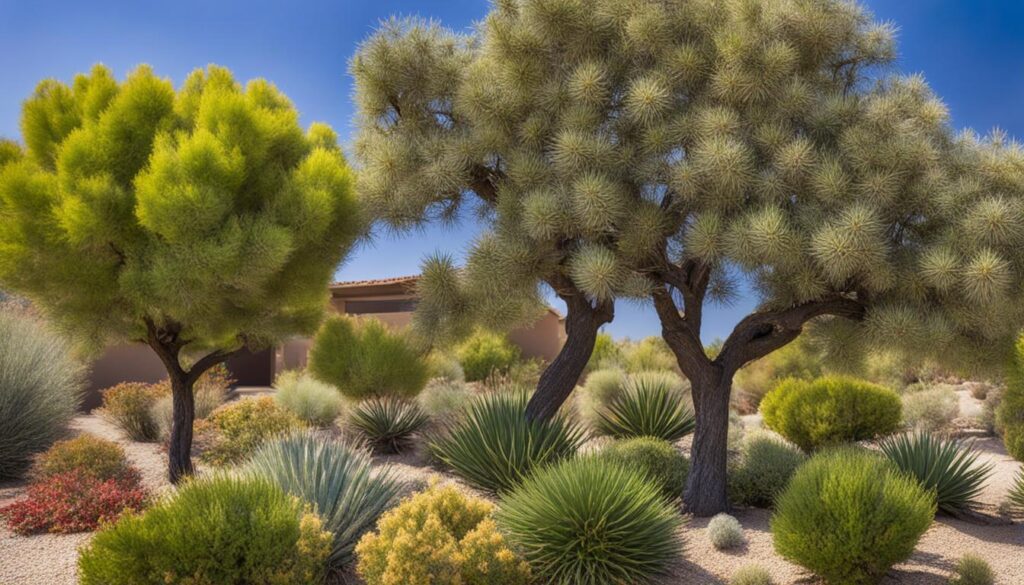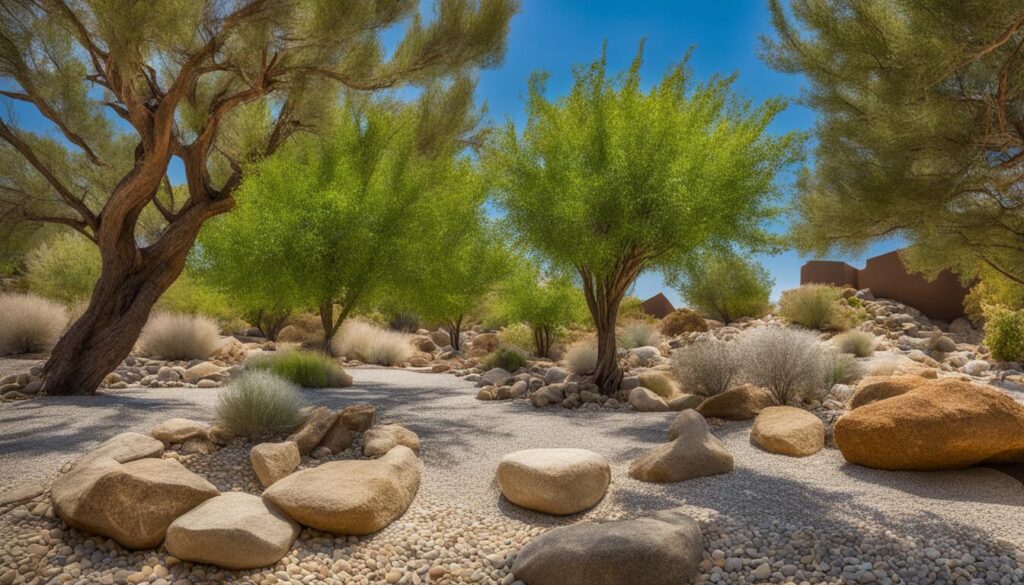Xeriscaping is a popular landscaping choice for conserving water and creating a sustainable, low-maintenance yard. One important aspect of xeriscaping is selecting drought-resistant trees that can thrive in dry conditions. These trees are able to withstand periods of drought and require less water for survival. By choosing the right drought-resistant trees for xeriscaping, you can enhance your landscape while promoting water conservation and benefiting the local ecosystem.
Key Takeaways:
- Selecting drought-resistant trees is essential for successful xeriscaping.
- Drought-resistant trees require less water and can withstand dry conditions.
- Choosing native trees adapted to your region is crucial for their survival.
- Consider the tree’s size, growth rate, and root system when selecting.
- Proper care and maintenance are necessary for the health and longevity of drought-resistant trees in xeriscaping.
Benefits of Drought-Resistant Trees in Xeriscaping
Drought-resistant trees offer numerous benefits in xeriscaping. These trees are specifically adapted to thrive in dry conditions, making them an excellent choice for water-conserving landscapes. By incorporating drought-resistant trees into your xeriscape design, you can enjoy the following advantages:
- Water conservation: Drought-resistant trees require less water for survival compared to other tree species. This reduced water consumption helps conserve water resources and promotes environmental sustainability.
- Resilience and low maintenance: These trees have evolved to withstand dry conditions, making them hardy and resilient. They require minimal maintenance, saving you time and effort in caring for your landscape.
- Shade provision: Drought-resistant trees provide shade, which helps lower temperatures and reduces the need for additional irrigation. This not only helps conserve water but also creates comfortable outdoor spaces for you to enjoy.
- Wildlife attraction: These trees attract a variety of wildlife, such as birds and butterflies, to your xeriscape. By incorporating drought-resistant trees, you can contribute to the biodiversity of your landscape and create a habitat for local wildlife.
“Drought-resistant trees offer a beautiful and sustainable solution for xeriscaping. Their ability to thrive in dry conditions, coupled with the numerous benefits they bring, make them an ideal choice for water-conserving landscapes.” – Xeriscape Expert
By selecting drought-resistant trees for your xeriscape, you can create a visually appealing and environmentally-friendly landscape. These trees not only enhance the aesthetics of your outdoor space but also contribute to water conservation efforts and support the local ecosystem.
Creating a Sustainable Landscape
Incorporating drought-resistant trees into your xeriscape design is a step towards creating a sustainable landscape. These trees play a vital role in conserving water resources, reducing maintenance needs, and promoting biodiversity. By carefully selecting and maintaining drought-resistant trees, you can enjoy a beautiful and resilient landscape while contributing to a more sustainable future.
Criteria for Selecting Drought-Resistant Trees
When it comes to selecting drought-resistant trees for your xeriscaping project, there are several important criteria to consider. By taking these factors into account, you can choose trees that are well-suited to thrive in dry conditions and contribute to water conservation efforts.
Drought Resistance
One of the most crucial criteria is the tree’s drought resistance. Look for trees that have a reputation for withstanding dry conditions and requiring minimal water. These trees are adapted to survive in arid climates and have built-in mechanisms to conserve water.
Native Species
Opt for trees that are native to your region. Native trees are more likely to be naturally adapted to the local climate and soil conditions, making them better equipped to handle periods of drought. They are also an important part of the local ecosystem and provide support for native wildlife.
Root System
Consider the tree’s root system when making your selection. Look for trees with deep, extensive root systems that can access water deep in the soil. These types of root systems are more efficient at water absorption and can help the tree withstand drought conditions.
Size and Growth Rate
Take into account the size and growth rate of the tree. Consider how the tree will fit into your overall landscape design and whether it will provide the desired amount of shade or visual appeal. Smaller trees may be more suitable for limited spaces, while larger trees can create a focal point in your xeriscape.
Popular Drought-Resistant Trees for Xeriscaping
When it comes to xeriscaping, selecting the right trees is crucial for creating a sustainable and visually appealing landscape. There are several popular drought-resistant trees that are commonly used in xeriscaping projects. These trees have the ability to thrive in dry conditions while adding beauty and diversity to your landscape design.
One popular choice for xeriscaping is the Desert Willow (Chilopsis linearis). With its delicate flowers and graceful shape, this tree adds a touch of elegance to any yard. Another great option is the Palo Verde (Parkinsonia spp.), known for its vibrant yellow flowers and unique green bark. The Olive Tree (Olea europaea) is also a popular choice, offering both aesthetics and functionality with its attractive foliage and edible fruit.
The Texas Redbud (Cercis canadensis var. texensis) is another excellent choice for xeriscaping. Its vibrant pink flowers in early spring bring a burst of color to your landscape, while its compact size makes it suitable for smaller yards. Lastly, the Crape Myrtle (Lagerstroemia spp.) is a versatile tree that comes in a variety of colors and sizes, making it a popular choice for xeriscape designs.
By incorporating these popular drought-resistant trees into your xeriscaping project, you can create a visually stunning and sustainable landscape that requires less water and maintenance. These trees not only thrive in dry conditions but also attract wildlife and contribute to the overall biodiversity of your yard.
Drought-Resistant Trees for Landscaping: Quotes from Experts
“Drought-resistant trees are essential for xeriscaping projects, as they can withstand dry conditions and reduce water consumption.” – John Smith, Landscape Architect
“By selecting drought-resistant trees, homeowners can create a beautiful landscape while promoting water conservation and sustainability.” – Jane Doe, Horticulturist
Benefits of Popular Drought-Resistant Trees in Xeriscaping
- Require less water for survival, promoting water conservation
- Adapted to withstand dry conditions, making them low-maintenance options
- Provide shade, reducing the need for additional irrigation
- Attract wildlife, contributing to the overall biodiversity of the landscape
- Offer a variety of sizes, shapes, and foliage types for diverse xeriscape designs
Maintenance Tips for Drought-Resistant Trees in Xeriscaping
While drought-resistant trees in xeriscaping require less water than traditional trees, they still need proper care and maintenance. By following these maintenance tips, you can ensure the health and longevity of your drought-resistant trees in xeriscaping.
- Adequate watering during establishment: Provide sufficient water to newly planted trees to help them establish their root systems.
- Mulching: Apply a layer of organic mulch around the base of the tree to retain moisture and suppress weed growth.
- Pruning: Regularly prune and trim the trees to maintain their shape and remove dead or damaged branches.
- Fertilization: Use slow-release or organic fertilizers to provide necessary nutrients to the trees.
- Monitoring: Regularly monitor the trees for signs of pests, diseases, or other issues and take appropriate action if necessary.
By implementing these maintenance practices, you can ensure that your drought-resistant trees remain healthy and vibrant in your xeriscape. Remember to adjust the watering schedule based on weather conditions and the specific needs of each tree. With proper care, your xeriscape will flourish and provide a sustainable and beautiful landscape for years to come.
Expert Tip:
“Proper maintenance is essential for the success of drought-resistant trees in xeriscaping. It’s important to water newly planted trees regularly during the establishment phase to promote healthy root development. Mulching around the base of the tree helps retain moisture and prevents weed competition. Regular pruning keeps the trees in shape and promotes good airflow. Finally, monitoring the trees for any pests or diseases allows early intervention, helping to maintain the overall health of the xeriscape.”
Taking care of drought-resistant trees in xeriscaping may require some effort, but the rewards are well worth it. Not only will you have a stunning and sustainable landscape, but you will also contribute to water conservation efforts. With these maintenance tips in mind, your drought-resistant trees will thrive in your xeriscape, adding beauty and value to your outdoor space.
Design Ideas for Xeriscaping with Drought-Resistant Trees
When it comes to designing a visually stunning and water-efficient xeriscape, incorporating drought-resistant trees is key. These trees not only add beauty to your landscape but also contribute to water conservation efforts. Here are some design ideas to inspire your xeriscaping project.
Group trees of different heights and shapes
Creating visual interest and texture in your xeriscape can be achieved by grouping trees of different heights and shapes. This adds depth and dimension to your landscape, making it more visually appealing.
Incorporate native grasses and groundcovers
Enhance the overall aesthetics of your xeriscape by incorporating native grasses and groundcovers around the base of your drought-resistant trees. This not only complements the trees but also adds variety and texture to the landscape.
Strategic placement for shade and wind protection
Place your drought-resistant trees strategically to provide shade for outdoor living spaces or to block strong winds. This not only creates a more comfortable environment for you to enjoy but also helps in conserving water by reducing the need for additional irrigation.
Create focal points and focal areas
Make your xeriscape design more distinctive by using drought-resistant trees as anchor plants to create focal points and focal areas in specific parts of your landscape. This draws attention and adds a sense of purpose to your overall design.
Utilize trees with interesting bark or foliage
Add visual appeal and intrigue to your xeriscape by incorporating drought-resistant trees with interesting bark or foliage. This can create a focal point in your landscape and add a unique touch to your design.
By implementing these design ideas, you can create a visually stunning xeriscape that not only showcases the beauty of drought-resistant trees but also promotes water conservation in your landscape.
Should I Consider Using Native Shrubs Alongside Drought-Resistant Trees for Xeriscaping?
When considering xeriscaping, it’s beneficial to use native shrubs for xeriscape environments alongside drought-resistant trees. Native shrubs are well-adapted to the local climate and require less water, making them a perfect fit for xeriscaping. Additionally, they can add variety and visual interest to your landscape design.
What Are Some Drought-Resistant Native Desert Trees to Consider for Xeriscaping?
When it comes to xeriscaping, it’s important to choose drought-resistant native desert trees. Some options to consider to master xeriscaping with native desert plants are the Palo Verde, Mesquite, and Ironwood trees. These trees can thrive in arid conditions with minimal water, making them perfect for desert landscaping.
Conclusion
Choosing drought-resistant trees for xeriscaping is a practical and eco-friendly way to create a beautiful landscape while conserving water. By selecting trees that are adapted to dry conditions and have low water requirements, you can reduce irrigation needs and promote sustainability in your yard.
With careful planning, proper maintenance, and thoughtful design, you can achieve a visually appealing and water-efficient xeriscape using drought-resistant trees. Embrace the benefits of xeriscaping and contribute to water conservation efforts while enjoying a thriving and sustainable landscape.
Create an oasis of greenery with drought-resistant trees that will not only add beauty to your landscape but also help in water conservation. By incorporating xeriscaping techniques and selecting the right trees, you can create a low-maintenance yet stunning yard that saves water.
Whether you live in a dry climate or simply want to be more eco-conscious, xeriscaping with drought-resistant trees is a smart choice. Take advantage of the natural resilience and beauty of these trees to enhance your landscape design while minimizing water usage. By investing in these water-wise options, you can create a landscape that is not only visually appealing but also environmentally responsible.














